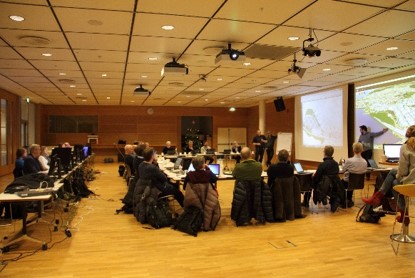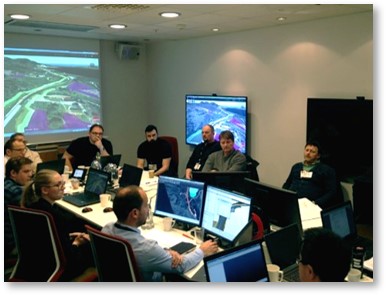Throughout my career I have experienced many project meetings that lasted way too long. Meetings which could in fact last less than 20 minutes ended after 2 hours, only to fill in the slot earlier booked in the calendars. Discussions dragged on forever, often concerning irrelevant topics, and the participants were unprepared. In 2017 when I first attended an ICE meeting dedicated to an infrastructure VDC project, I felt like I was in a completely different world. The world where all participants are involved, the agenda is monitored down to the minute and decisions are made during one session.
After reading the first article from this series about VDC (LINK HERE) it’s time to find out what the ICE method really is. I’ll describe the benefits of implementing this method and tell you more about the challenges it brings.
Table of content
1. Why traditional methods are ineffective?
1.1. Lack of communication
As a rule, traditional projects are executed in a “relay” system. Each discipline carries out a specific task and transfers the results further, to the next one in the relay – often with limited exchange of information and discussion on project challenges. “I did my job, now it’s your turn.” In other words, such a working system reminds me of playing the Chinese whispers: each discipline is supposed to deliver information to the next industry without revealing it to other industries so that they can’t interfere. Such limited information exchange may lead to serious misunderstandings (see Figure 1).
The vast majority of the problems encountered during meetings occur due to miscommunication. Additionally, trying to work across different teams and companies doesn’t make it easier.
This is how designing looks today
We work independently.
Sitting in separate places.
Doing individual tasks.
Working on different project phases, without set goals.
Sign up for free mailing and you will receive Grasshopper TIPS every week.
Join NOW – I’ll send the first secrets of Grasshopper right away!
1.2. Decision making
The second-worst nightmare, right after communication, is decision-making. In most projects the hierarchy is fairly simple. All decisions must be accepted at certain hierarchy level and sent further for approval. Afterwards, the decision returns the same way to its starting point. Unfortunately, this procedure may take up to several weeks – depending on the length of the approval chain. It’s an ineffective approach to solving problems, especially in cases where time is essential.
Time for change...
As you can see, dear reader, such an approach to design needs urgent transformation. Unfortunately, the old methods and patterns often hinder new approaches and practices. Too short design phase and the contractor’s urge to start construction early drastically affect the quality. Companies are required to build before the design phase is finalized, while problem-solving is pushed into the construction phase. At the same time, experience shows that the more we plan, the less surprises will pop up in the construction phase. Nowadays, we need flexible and universal solutions.
2. Where did ICE come from?
The origins of ICE date back to the mid-90s. The legendary Team X from NASA Jet Propulsion Laboratory (JPL) was the first to develop a method of conducting meetings in an integrated and simultaneous manner. Primally, it was caused by the increase in the number of space mission initiatives announced by NASA in the late 20th century. Furthermore, NASA focused more on precise control of the costs which, if exceeded, could lead to complete cancellation of the mission. Extreme Collaboration – as the method was initially named – established an integrated design process. It lasted 3 weeks instead of 9 months, as happened on previous projects. To make it possible the JPL group carried out the majority of the engineering and coordination work in merely nine hours using the latest visualization technologies. (see fig. 2).
You can find more information about extreme collaboration here.
After that, Stanford University implemented the methodology developed by NASA in 2004. It has been focused on the construction and design of engineering structures, with particular focus on the early design phase, which required high engagement in multidisciplinary planning and coordination. The method has been closely linked to – and actually relies on – the BIM methodology. Above all, after several years of research, Stanford University implemented it into the VDC methodology naming it ICE – Integrated Concurrent Engineering.
3. What does the ICE stand for?
-
I - Integrated - stands for the integration of all disciplines. Many disciplines involved in construction projects require joint work to achieve set goals.
-
C – Concurrent - workflow is carried out simultaneously, not in a sequential manner. The simultaneous performance combines and integrates all disciplines, thus ensuring better results.
-
E- Engineering –the method has an “engineering” approach to the workflow. It identifies problems, instead of creating them. Once a problem is tracked down, a solution is created, and consequently, immediate correction is made.
Integrated Concurrent Engineering in VDC method
Definition: Integrated Concurrent Engineering (ICE) is a social method, helped by technology, to create and evaluate multi-discipline, multi-stakeholder VDC models extremely rapidly.
John Kunz et al. 2004
Let’s extend it a little bit.
ICE is a meticulously planned multidisciplinary meeting, with simultaneous design work. The works aim at solving design challenges. Significant decisions concerning the project are made in real-time. Meetings are organized with the latest visualization technologies in specifically designed rooms, known as Big Rooms. The participants use projectors and large touch screens displaying BIM models. Based on such models, the participants analyze problems and discuss solutions. Additionally, the meeting plan and agenda are supervised by the so-called facilitator – a person responsible for the smooth course of the meeting, implementing a predefined program down to a minute. Their duties include inviting relevant project participants and helping to break the deadlock in the decision-making process. The organizational hierarchy of meetings is straightforward, which additionally simplifies communication.
4. Key aspects of ICE
If you do not agree on the problem you will not agree on the solution
Martin Fischer
4.1. Making a decision
Efficiency in decision-making represents an absolutely fundamental measure of project performance. At times, the designing itself may be shorter than the decision-making process. In general, it’s not dependent on the designers, but on the customer. Therefore, the customer must involve all the decision-makers in the meeting. Research carried out by Beccerik and Pollalis (2006) reveals that with integrated design environments the waiting time for a decision may be reduced almost to one third.
You can find more about the research here: Sanches, A., In Hampson, K.,& Vaux, S. Delivering value with BIM: A whole-of-life approach. New York, NY: Routledge,
4.2. Receiving a response
Receiving the relevant information at the right time from a given discipline may be crucial for the overall investment. Frequently, the time between asking a question and receiving the required response lasts forever. It slows down the whole process, significantly increasing the risk of redesigning.
For instance…
…let me refer to the award-winning UCSF Mission Bay Hospital project. The hospital opened in 2014 after 45 months of design and construction. By applying the VDC method, the total budget was reduced from assumed 965 million dollars to 765 million dollars. Team members provided weekly reports regarding the outcomes of ICE meetings. The results are: 80% of all problems brought up at the ICE meeting were solved within 30 minutes or less. Furthermore, the vast majority of the remaining challenges were solved in 4 hours or less.
You can find more about the project in the book: Integrating Project Delivery by Martin Fischer, Howard W. Ashcraft, Dean Reed i Atul Khanzode. part 8.6. A case study: Integrating the UCSF Medical Center Mission Bay Hospitals Project.
4.3. Co-location
Co-location is nothing more than bringing together the entire project group in one physical place. Gathering all the designers in one building plays a huge role in the whole project. An hour spent in an integrated team has a significantly higher impact on the project than eight hours spent on individual work. Unfortunately, for practical reasons, it isn’t always possible for everyone to work in one city/building. However, teamwork in the same room, even once a week, may already bring the desired results.
Norway is a good example. The majority of multidisciplinary projects here involve just one company. Partly because of the market structure: 6 large multidisciplinary companies call the shots at major tenders. Companies employ all the required industry professionals to deliver the project with their resources. Such a workflow revealed a significant increase in design efficiency. In conclusion, the designs are delivered faster and in higher quality.
Figure 3. Examples of ICE meetings held at Sweco in Norway
5. Benefits of ICE
5.1. Time
- Reduced number of redesigning thanks to easier communication in an integrated team
- Faster decision making by involving all decision-makers in meetings
- Improved problem clarification through the active involvement of all participants
- Faster and more efficient design due to the simultaneous work of the designers
- Meeting deadlines by integrating the organization, processes, and BIM model
- Shorter meetings resulting from meticulous tracking and following the agenda
5.2. Quality
- Optimized solutions achieved with multiple iterations
- Increased innovation through the application of modern technologies
- Improved quality of the delivered product due to teamwork
- Increased productivity resulting from the efficient and optimal use of human resources
- Easier project management due to transparent group work
5.3. Integration
- Improved communication, education and experience exchange through wider interaction among participants
- Increased sense of belonging and the meaning of own role among project participants
- More creative ideas and solutions resulting from analyzing the problem from different perspectives
- Focusing on the relevant problems thanks to prioritizing tasks
- Better relationships among the participants
6. Challenges of ICE method
- The method may not be applicable to all projects, especially small, with only a few disciplines involved.
- It’s not reasonable to apply the method in projects without 3D models, which constitute the very base for discussion at the ICE meeting.
- The attendance of many people in the room may be overwhelming and disturbing for some. People working in the silence of their own offices every day may not feel comfortable working in the “open space” style, especially that it may get even more OPEN than usual at ICE meetings.
- Early involvement of all disciplines may be problematic. Those whose role at the first session is passive, yet required, may underestimate the value of the method. Thus, their involvement in subsequent meetings will decrease.
- Investment in new technologies may be expensive. Rooms require big touch screens, projectors, microphones, and cameras for teleconferences.
- Adapting to a new pace and rhythm may be challenging for certain employees.
- The success of the method lies in the presence of all decision-makers at the meeting. Of course, no one is irreplaceable. It’s always possible to have representatives of the given discipline. However, it will significantly slow down the pace of the meeting. After that, many planned issues may be left unexplained. Perhaps the representative may not be sufficiently informed or authorised to make key decisions efficiently.
- Above all, ICE requires teamwork skills. Individuals who don’t always get along with everyone in the team might have difficulty in finding themselves in the meeting. Particularly during meetings where the number of decisions is minimized and the number of solved problems maximized.
- ICE meetings gather employees from different companies. Usually, these companies have diverse working cultures and attitudes towards the employee. Such differences may be easily noticed in the course of a project and become a challenge.
7. Summary of the ICE in VDC method
In conclusion, the extended design phase becomes increasingly important throughout the project. Years of experience have confirmed that sooner or later we’ll all pay a high price for the lack of proper coordination. The ICE methodology doesn’t solve all the design concerns and problems. It’s just a tool, and these are people, not tools, that matter the most. People are the key to success of the whole project. ICE methodology is only there to help them.
If you liked the article, leave a comment and describe your experiences with traditional or ICE meetings. In comments below please tell us the most disturbing aspects of the project meetings you’re participating in. Or email us on [email protected] – we always answer.
In the next articles of this series, you will learn more about the ICE methodology. The upcoming article will be devoted to the roles in ICE – what are the responsibilities of particular employees and what qualities a good meeting facilitator should possess.
Bibliography:
https://en.wikipedia.org/wiki/Concurrent_engineering
http://v1.prosjektnorge.no/files/pages/635/artikler/veiledere/a5_veileder-ice.pdf
https://www.samtidigprosjektering.no/















BIM specialists should have a thorough understanding of the processes involved in the construction of buildings and different types of projects.
I only understood that all that you need for successful meeting is to collect all decision-making people in appropriate room=)